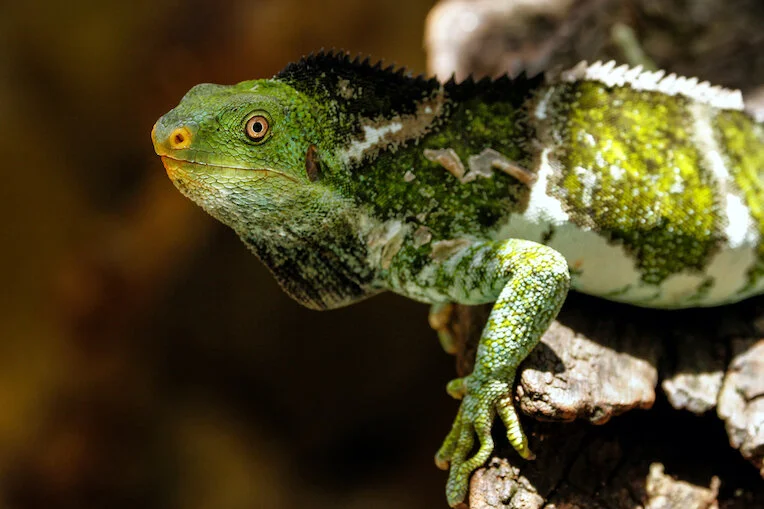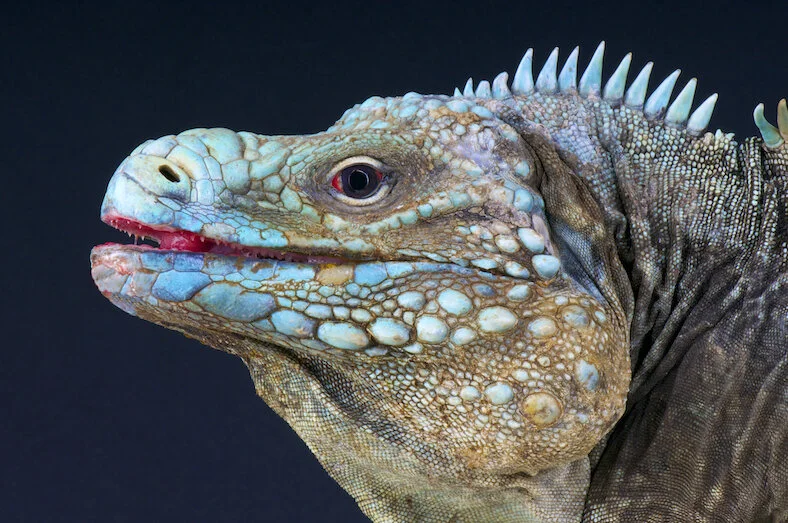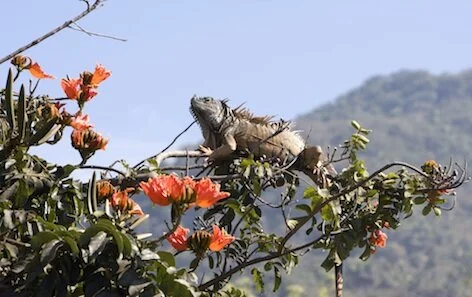Iguanas are lizards.
Some iguanas live in deserts and some live in forests.
One kind of iguana swims in the sea.
Iguanas eat flowers, fruit and leaves.
Female iguanas lay eggs.
The Critically Endangered Fijian crested iguana ©Getty Images
What are iguanas?
Iguanas are large reptiles. They are part of the lizard family. There are many different species (kinds) of iguana, such as green iguanas, Fijian banded iguanas and Fijian crested Iguanas.
There are also marine iguanas and desert iguanas.
Habitat and distribution (where they are found)
Iguanas are found in tropical areas of Mexico, Central America, some Polynesian islands such as Tonga and Fiji, and the Caribbean. Some species live in dry habitats such as deserts of New Mexico and Arizona, while others live in tropical rainforests where it's warm and wet.
A rare blue rock iguana, found only on Grand Cayman Island near Cuba ©Getty Images
Marine iguanas
One unique species lives on land and feeds in the sea near the Galapagos Islands off the coast of Ecuador. They are marine iguanas, the only lizard species that swims in the sea. Scientists believe their ancestors floated from South America to the islands on bits of wood, and had to adapt to the harsh environment in order to survive.
Now the marine iguanas on each of the Galapagos Islands are different in size, shape and colour from the others. Their adaptations include short snouts and small, very sharp teeth in order to scrape algae off rocks, and the flattening of their tails so they can move through the water in a similar way to that of crocodiles. The algae and seaweed they eat is very salty, and they have developed special glands to clean the salt out of their blood.
Appearance and Behaviours
A rhinoceros iguana in the process of shedding its skin. See the dark skin underneath. ©Getty
Iguanas have a dewlap, which is a flap of skin hanging under their chin. They have a row of spines running down their back to their tail, and a third eye on their head. This eye is known as the parietal (say pa-rye-uh-tul) eye, which looks just like a pale scale on the top of their head. Behind their neck are small scales which look like spikes, and a large round scale on their cheek.
Some species can grow as large as 1.8m long, including tail. Iguanas have excellent eyesight, and use their vision as they move through the forest looking for food.
As reptiles grow, their skin does not grow as ours does. Like other reptiles, iguanas moult, or shed their skin, each year, revealing a new, larger skin underneath.
A green iguana resting on a branch. ©Getty
Many iguanas live in trees, where they lie still, using their colour to camouflage themselves.
Like all reptiles, iguanas need to bask in the sunlight, which warms the outside of their bodies because their bodies can't do it from the inside. This means iguanas are generally active during the hours of daylight.
Iguanas are not fierce and some kinds are popular as pets.
Diet
A brown iguana feeding in a treetop. ©Getty
Iguanas are herbivores, they eat mostly plants such as fruit, leaves, berries and flowers.
Marine iguanas eat seaweed and sea algae.
A marine iguana feeding on algae under the sea. ©Getty Images
Iguana Life cycle
All species of iguana lay eggs. After mating with a male iguana, a female digs a nest and lays up to 70 eggs in it. She buries the eggs. The young hatch after about 10 - 14 weeks, although much longer for the Fijian crested iguana, and dig their way to the surface. Baby iguanas grow slowly. They become adults and able to mate when they are 2 years old. Some iguanas can live for 30 years.
Conservation and Threats
©Getty Images
A number of species, including Fijian crested iguana, Galapagos pink land iguana, Utila spiny-tailed iguana, are classified as Critically Endangered.
A number, including the green iguana, or West Indian iguana, and the Fijian banded iguana are classified as Endangered.
Some, including the marine iguana and the Santa Fe land iguana are classified as Vulnerable.
Some are classified as not being of concern, or else not enough information is available to make a decision.
It’s a good idea to get information from more than one source!
Read more about iguanas
https://www.coolkidfacts.com/iguana-facts-for-kids/
Read about green iguanas
https://www.ducksters.com/animals/green_iguana.php
Read about marine iguanas
http://www.worldwildlife.org/species/marine-iguana









